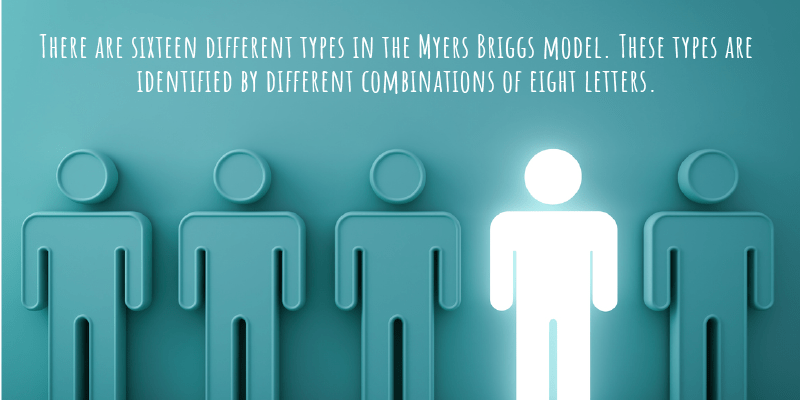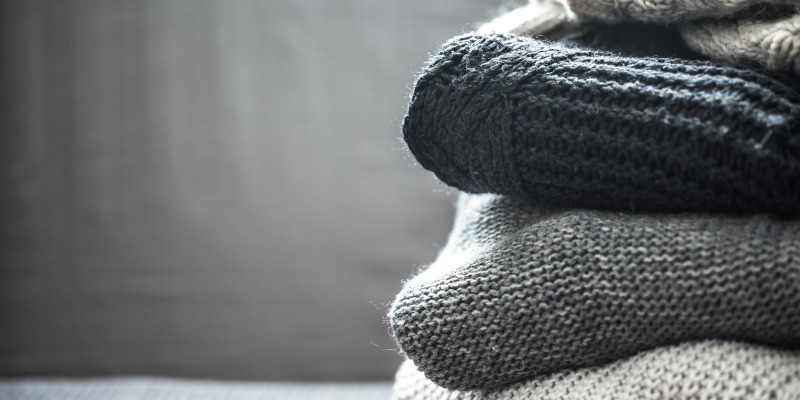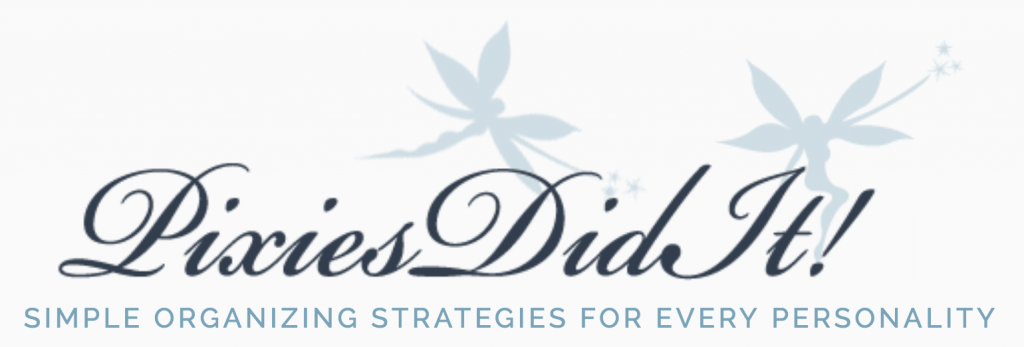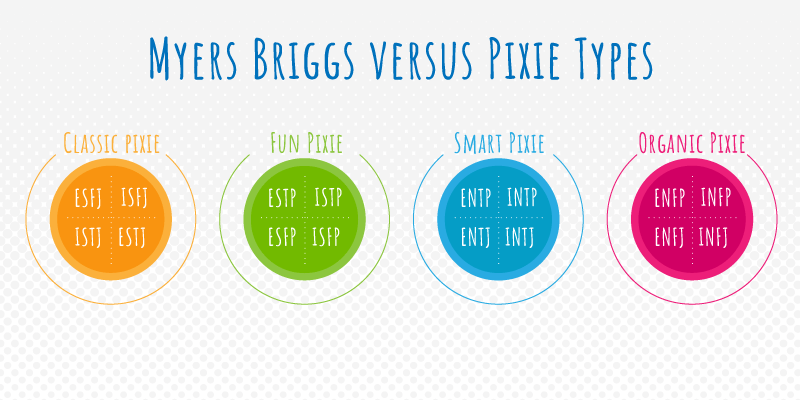Myers Briggs Versus Pixie Types: A Guide
Using the Myers Briggs Type Indicator as an initial guide with our clients, we invented what we like to call ‘Pixie Types’. You might be asking yourself, “what does personality type have to do with organization?” As far as we are concerned, everything. We believe that there is no ‘one size fits all’ in terms of getting and staying organized, and that if we were to give people advice on how to organize their homes, we needed to tailor this advice to fit each person, or personality. As we wrote in our book, Organize Your Way, “Different people need different solutions.” Hence the development of Pixie Types. Are you a Classic, Fun, Organic, or Smart Pixie? (Find out by taking our Pixie Personality Quiz, available online and in our book.) So, just what do these types mean, and how did we come up with them? Most importantly, what in the heck do they have to do with home (and life) organization?
Read on and find out!
Myers Briggs: A Quick Rundown

The Myers Briggs Type Indicator is a personality test that was developed in the 1940s by Isabel Briggs Myers and her mother, Katharine Briggs. These women based their personality typing methodology on famed psychologist Carl Jung’s theory of psychological types. Jung believed we could analyze human behavior via the differences in how individuals used their powers of perception and judgment — in other words, how people experienced and made sense of the world around them. There are sixteen different types in the Myers Briggs model. These types are identified by different combinations of eight letters. Each letter indicates the way we interact with the world, process information, make decisions, and implement structure into our daily lives. These aspects have everything to do with organization. (Is the method to our madness becoming clearer?)
We’ve listed the letter pairings and their meanings:
Letter pairings and Their Meanings
- E/I: (Extraversion versus Introversion) Oftentimes we think we have a good idea of what extravert and introvert mean, but our explanations are often simplistic (Extraverts like to party, and introverts are boring, right? Wrong! Not even the explanation of how we get our energy — extraverts from others, introverts from alone time — is entirely accurate). In actuality, these two letters refer to whether we focus on our outer (external) or inner (internal) worlds. Are we more comfortable looking outward, or turning inward?
- S/N: (Sensing versus Intuition) This letter combination refers to the way in which we process information. Do we rely on the basics (just the facts, ma’am), or do we enjoy taking that information and interpreting and finding meaning in it (analysis at its best)? The question is not whether or not we possess intuition, but rather, whether we use that intuition to make sense of the events occurring around us.
- T/F: (Thinking versus Feeling) These two letters represent the way we make decisions. Do we rely on pragmatism, or do we lean on our emotions? Do we use consistency and logic, or people and circumstance to determine whether or not to do a thing?
- J/P: (Judging versus Perceiving) This combo refers to the way we like to go about things once we have the necessary information we need. Do we enjoy having things settled and decided, or are we more comfortable existing in the land of possibility and potential?
Our main divergence with Myers Briggs starts with the fact that we found the E/I part of each person’s personality type didn’t impact how a particular personality type organized. As in we spent 10 years in people’s homes, knowing their personality types, watching how they organized. Not quite Jane Goodall type observations in the wild but close. As a result, we discovered that are only eight Pixie organizing Types.
Pixie Types: A Quick Rundown
ESFJ, ISFJ, ESTJ, ISTJ: (Classic Pixie Types)
Classic Pixie Types are your basic traditional (some would say anal retentive) organizer. There are Classic Freedoms (ESFJ, ISFJ) and Classic Structures (ISTJ, ESTJ). Both have a natural aversion to clutter and prefer that things be hidden rather than out in the open. They stick to details and schedules. These are routinized beings who like advance plans, filing cabinets, proper piles (maybe they pile things like coffee table books every once in a while) and actual, written-out To Do lists. They tend to take everything on and thusly have trouble delegating tasks to others. As a result, and because they hate clutter more than anything, they often find themselves stuffing things into already crowded spaces. Think: a closet that looks fine when shut but explodes upon opening. Classics can be extraverted or introverted, and can use emotions or logic to make decisions, however: their main attributes (sensing and judging) never change. They always rely on the basic facts, and they always like having things settled and decided.
ESTP, ISTP, ESFP, ISFP: (Fun Pixie Types)

Fun Pixie Types are what we like to call ‘master improvisers’. There are Fun Freedoms (ISFP, ESFP) and Fun Structures (ISTP, ESTP) Their spontaneity/pragmatism makes them invaluable in a crisis. We like to compare Funs to MacGyver (are we dating ourselves?) or a more easygoing James Bond type. These types naturally live in the present moment, and yet are firmly grounded in the realities of everyday life. Though they have a genuine sense of fun (hence the name), they are detail-oriented, habitual creatures who get things done. They can file things if given an easy system (color-coordinated things work very well for this type) and do their best work when inspired. As a result, certain rooms are kept very neat and others, well…are merely ‘kept’. Fun chefs maintain an immaculate kitchen, Fun clotheshorses a perfectly organized walk-in closet. Funs detest boring projects and generally don’t enjoy making advance plans. But, think of it this way. They may fly by the seat of their pants, but they always have an extra pair on them, just in case. Ha!
ENFP, INFP, ENFJ, INFJ: (Organic Pixie Types)

These softies have a tough time letting go of sentimental items (or really any items). There are Organic Freedoms (INFP, ENFP) and Organic Structures (INFJ, ENFJ). Perhaps the most sensitive of the bunch, Organics love to be surrounded by beloved items sometimes lots of them. They possess visual memories and like to keep things out in the open, which helps them to orient themselves. Think open storage in the kitchen, cubbies in the entryway, transparent storage bins, etc. They are not usually detail-oriented, and pile things at random. Their biggest organizational stumbling blocks? Overthinking organizational projects. Now, Organic Structures eventually get them done as they use To Do lists and planners. Unfortunately, Organic Freedoms sometimes overthink so long that they never begin them, ignoring details, and not putting items back where they belong. Organic Freedoms are similar to Funs in that they hate boring routines and need to feel inspired before tackling a project. All you Organic types: think there is no hope for you? Think again! We’ve got solutions (just keep reading our blog and you’ll find them, promise).
ENTP, INTP, ENTJ, INTJ: (Smart Pixie Types)

These personality types excel at big picture thinking, and are often leaders in their community and/or in the workplace. Because they tend to miss certain small but important details, it is important for them to keep things out in the open instead of hidden (like Organic types, they have visual memories). Although certain Smart types can excel at structure, planning (with the help of their e-calendars, day planners or personal assistants), and follow through (INTJ, ENTJ), others struggle with the ins and outs of daily, organized living because they are too busy envisioning grand schemes and plans to finish what they start (INTP, ENTP). Smart personality types easily resort to intentional piling and struggle with occasional rigidity, overlooking seemingly insignificant details. Furthermore, they have a certain amount of stubbornness in regards to the way things get done and can completely forget about things that aren’t directly in front of them and visible.
Finally, it’s incredibly important to note that none of these personality types are ‘better’ than the others, nor do they indicate a better chance of getting organized. Rather, they are the building blocks to organizing in a way that works for YOU. Ahem, not your spouse, best friend, or neighbor. You. With this knowledge, you’ll be better able to determine your personality type. Then, from there tackle any home or life organizational issue with flying colors.



2 Comments. Leave new
Don’t see an entj! And the logos don’t correspond with the categories broken down. I like the idea though!
You’re a Smart Structure! And If you go to Types it has the ENTJ and INTJ (we don’t differentiate with introversion and extraversian) you can read the description…Let us know what you think!